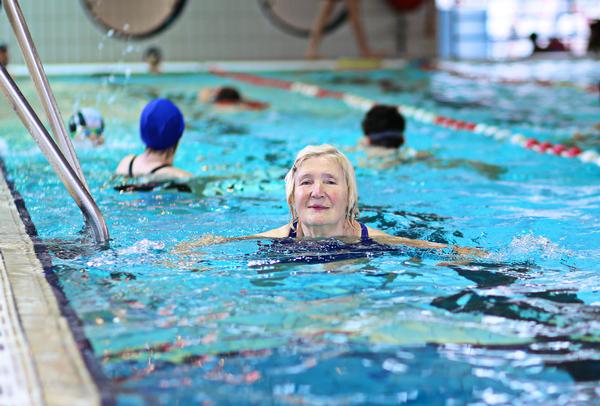 SELECTED
ISSUE
SELECTED
ISSUE
|
|
Leisure Management - The £1bn Wellness network

Talking point

|
|
| The £1bn Wellness network
|

ukactive chair Tanni Grey-Thompson has an ambitious vision for UK healthcare provision: a move away from illness and towards wellness, centred around a network of community wellness hubs. How can we make this a reality? Kath Hudson reports
|


With funding, leisure centres could become a preventative frontline for the NHS in the future PHOTO: SHUTTERSTOCK.COM

GP services at leisure centres could positively impact public health PHOTO: SHUTTERSTOCK.COM
|
|
|
Tanni Grey-Thompson believes a paradigm shift is necessary to address the UK’s inactivity problem, which costs £20bn each year and is the fourth biggest cause of disease and disability. Her vision involves a £1bn regeneration scheme which would transform the UK’s ageing fleet of leisure centres into community wellness hubs. Swimming pools, sports halls and gyms would be combined with GP drop-in centres, libraries and police services to create one-stop shops for public services – all of which would, she believes, bring huge opportunities for the health and fitness sector. She explains: “By co-locating leisure, health and other community services, we can remove barriers to physical activity and make wellness hubs the preventative frontline of the NHS. “Figures show such wellness hubs can drive greater levels of activity and have a profound impact on community health – all of which brings significant opportunities for both public and private gym operators. I genuinely believe wellness hubs hold the key to unlocking greater penetration rates for gyms nationwide, moving us well beyond the 14 per cent and taking physical activity truly into the mainstream.” So what do we need to do to make this vision a reality, and how have the sport and leisure sectors responded to Grey-Thompson’s call to action?
|
|
 |

Tanni Grey-Thompson
Chair
ukactive
 |
|
It’s important to note that wellness hubs are not a distant dream of the future. There are already 20 across the country, improving the health of communities, running without subsidy and delivering income to local authorities to cover the cost of borrowing. This level of return is vastly different from current centres and is giving real confidence to private investors.
The key to making our ambition a reality is building broad consensus across government, local authorities, operators and investors on the merits of this proposal and the best way to advance it. The campaign is already gaining momentum: ukactive is working closely with Sport England to comprehensively build the case, which has led to highly productive meetings with top-tier investors, leading construction firms, local authorities and high-level government figures.
Official calculations suggest it would take £1bn of investment to make the current leisure infrastructure more efficient and effective for community needs in the future. Ideally, the rollout of up to 750 wellness hubs under this £1bn programme would follow Sport England’s Strategic Facilities funding model, leveraging a ratio of 10:1 for private against public funding.
If £100m of combined public money couldn’t be raised, then some form of government guarantee against the capital loan for the programme would give pension funds and other potential private investors real confidence and allow them to offer competitive interest rates for the money to be borrowed by local authorities.
This level of investment is a drop in the ocean compared to the cost to the NHS of a full-blown inactivity epidemic. A radical overhaul of our leisure infrastructure would also stimulate economic growth and jobs. Better still, it would catapult our sector into the very heart of the preventative health agenda, making physical activity the lynchpin of happier, healthier and more prosperous communities.
"The required level of investment is a drop in the ocean compared to the cost to the NHS of a full-blown inactivity epidemic " – Tanni Grey-Thompson
|
|
|
In principle, sporta is strongly supportive of a bold initiative to produce additional public funding for a major development of public wellness centres. A broad consensus with all interested parties will help build the strong and expert case for the necessary government support and the sound arrangements for managing the proposed programme.
Delivering the vision ultimately depends on the provision of services, not just construction and co-location of facilities. Trusts and other not for profit/public benefit bodies, working with local authorities, will be the best operators of the facilities. These organisations have a community mission that’s well suited to these requirements, as well as the necessary capabilities and skills – including the ability to draw in volunteers.
Established ways of providing the individual services within an integrated wellness offering may need to change. The design and delivery of the leisure element may also need to be different, in particular to ensure it’s appropriate for populations that remain difficult to attract into physical activity.
Reaching out to the physically inactive groups in society will be costly and will need to be recognised in the local business model. There will need to be community outreach work, as well as partnerships with local charities and social agencies.
Getting the additional public funding and support essential to achieve the vision will clearly be a huge challenge. The approach being taken by ukactive and Sport England – to link with industrial infrastructure programmes and draw in commercial ‘social mission’ funding – is potentially the only way to enable a co-ordinated programme which provides scale and pace.
However, the broader social regeneration and inclusive growth case for a broad range of government funding and support for local public sport, leisure and cultural services should still be kept on the table. There may be new opportunities to argue this case when Brexit is implemented and the framework set by EU fund comes to an end.
"Trusts have a community mission that’s well suited to these requirements, as well as the necessary capabilities and skills" – Brian Leonard
|
|
 |

Stuart Lockwood
CEO
Oldham Community Leisure
 |
|
I very much welcome Tanni’s call to action. New surgeries, hospitals and leisure centres are being built all the time, and by joining up the thinking we can improve the outcomes for users, as well as save on overheads.
In theory, a joined-up perspective is more likely to happen now that much of the health sector is based within local government. The challenge lies in getting all parties on-side. Reinforcing the benefits and incentivising councils through planning guidance could help make these wellness hubs more likely to be considered.
Ideally, priority should be given to areas of highest health deprivation, but reality dictates that consideration for new sites will only happen when the existing ones are no longer fit for purpose. GP clusters are being encouraged to take charge of their businesses, but this independent thinking may not involve thoughts of library and physical activity provision.
What’s needed is a quick and seamless process for users: accessing a physical activity intervention needs to be as quick and easy as collecting medicine. While co-location is ideal, in the meantime we should try and improve links between existing assets.
New money to finance wellness hubs would be great, but if we could guarantee existing money were spent better, that would be a significant step forward. Pooling resources, rather than defending budgets in silos, is the smarter way to invest. Ultimately developments should be judged on their impact on engagement and uptake.
"While co-location is ideal, in the meantime we should try and improve links between existing assets"
– Stuart Lockwood
|
|
 |

Giles Rawlinson
Acting MD
Parkwood Leisure
 |
|
Leisure is a non-mandatory local authority service which is under threat in many areas because of budget cuts and austerity measures. Like everyone who’s passionate about the sector, we therefore wholeheartedly support Tanni Grey-Thompson’s call for a £1bn investment programme to make leisure centres the preventative frontline of the NHS.
Investment into combined facilities – including health consultation rooms and leisure – would revitalise a generation of leisure centres, assuring their future and providing a huge boost to their work to improve public health, in turn resulting in significant long-term savings for the NHS and improved health outcomes for our communities.
Within our dedicated leisure sites, Parkwood is already rising to this challenge with centres showing themselves to be highly effective in supporting GPs. Since its inception in Bexley – where more than 30 per cent of adults are classed as inactive – Parkwood’s Steps to Health exercise referral scheme has helped improve the wellbeing of thousands of residents with medical conditions ranging from obesity and diabetes to dementia and depression.
This programme is an example of how health and leisure could be more joined-up, to benefit the community at large and reduce the cost impact on the NHS by delivering health and activity interventions instead of prescriptions.
"Health and leisure could be more joined-up, to deliver health and activity interventions instead
of prescriptions" – Giles Rawlinson
|
|
 |
| Originally published in Health Club Management 2017 issue 5
|
|
 |
|